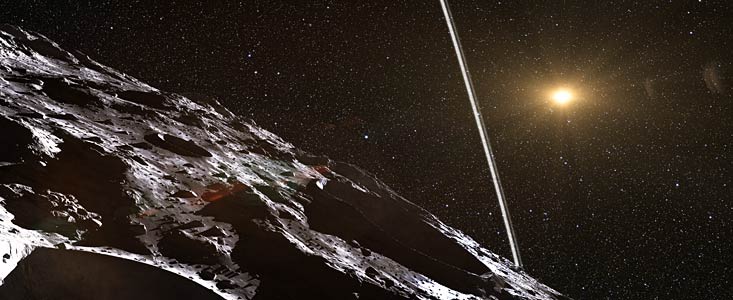
 Observations at many sites in South America have made the surprise discovery that the remote asteroid Chariklo, only 100 miles in diameter, is surrounded by two dense and narrow rings. This is the smallest object by far found to have rings and only the fifth body in the solar system—after the much larger planets Jupiter, Saturn, Uranus and Neptune—to have this feature.
Observations at many sites in South America have made the surprise discovery that the remote asteroid Chariklo, only 100 miles in diameter, is surrounded by two dense and narrow rings. This is the smallest object by far found to have rings and only the fifth body in the solar system—after the much larger planets Jupiter, Saturn, Uranus and Neptune—to have this feature.
“We weren’t looking for a ring and didn’t think small bodies like Chariklo had them at all, so the discovery—and the amazing amount of detail we saw in the system—came as a complete surprise!” says Felipe Braga-Ribas (Observatório Nacional/MCTI, Rio de Janeiro, Brazil) who planned the observation campaign.
Chariklo is the largest member of a class known as the Centaurs and it orbits between Saturn and Uranus in the outer solar system. Predictions had shown that it would pass in front of the star UCAC4 248-108672 on 3 June 2013, as seen from South America. Astronomers using telescopes at seven different locations were able to watch the star apparently vanish for a few seconds as its light was blocked by Chariklo.
But they found much more than they were expecting. A few seconds before, and again a few seconds after the main occultation there were two further very short dips in the star’s apparent brightness. Something around Chariklo was blocking the light! By comparing what was seen from different sites the team could reconstruct not only the shape and size of the object itself but also the shape, width, orientation and other properties of the newly discovered rings.
The team found that the ring system consists of two sharply confined rings only seven and three kilometers wide, separated by a clear gap of nine kilometers.
“For me, it was quite amazing to realize that we were able not only to detect a ring system, but also pinpoint that it consists of two clearly distinct rings,” adds Uffe Gråe Jørgensen (Niels Bohr Institute, University of Copenhagen, Denmark), one of the team. “I try to imagine how it would be to stand on the surface of this icy object—small enough that a fast sports car could reach escape velocity and drive off into space—and stare up at a 20-kilometer wide ring system 1,000 times closer than the Moon.”
WESTCHESTER STAR PARTY. Meanwhile, much closer to home, on Saturday April 5th the local community will be able to look up at our own Moon and planet Jupiter and see them greatly magnified in high-quality amateur telescopes. The international public astronomy organization “Astronomers Without Borders” has named April 5 as Global Star Party Night, when people all over the world will be looking through telescopes—often for the first time in their lives. The local star party will be part of this global adventure. (astronomerswithoutborders.org/gam2014-programs/observing/1455-global-star-party.html.)
Telescope will be set up for the public’s enjoyment from 7:30 to 10:00 p.m. in the parking lot of the Christian Science Church, 7855 Alverstone Ave. (1 block west of Sepulveda at the corner of 79th St.) in Westchester. There is no charge, and refreshments will be served. If you have a telescope of your own, you’re welcome to bring it.
All are welcome—bring the children, learn astronomy together, and enjoy the sky! And if it’s cloudy, come anyway—we’ll have an indoor learning session on basic astronomy designed especially for children (of all ages).
Questions? Contact star party host Bob Eklund, (310) 216-5947, [email protected]


Be the first to comment